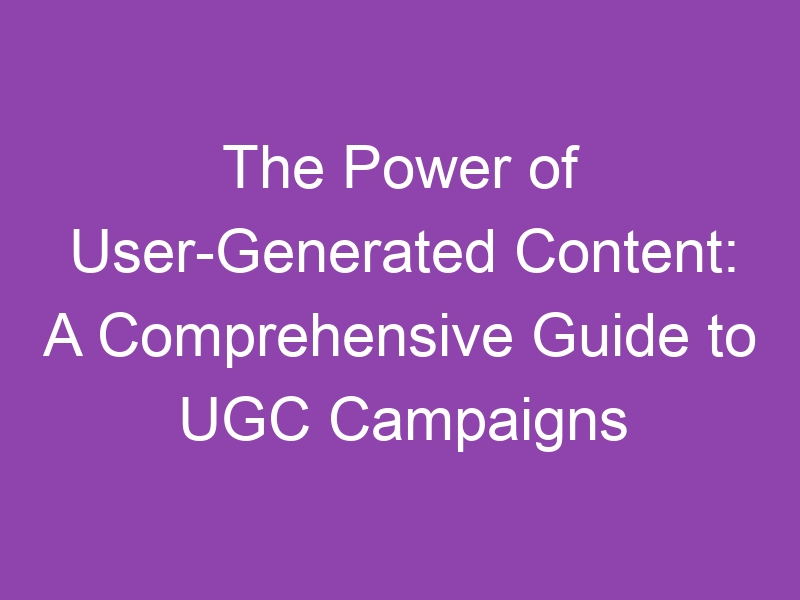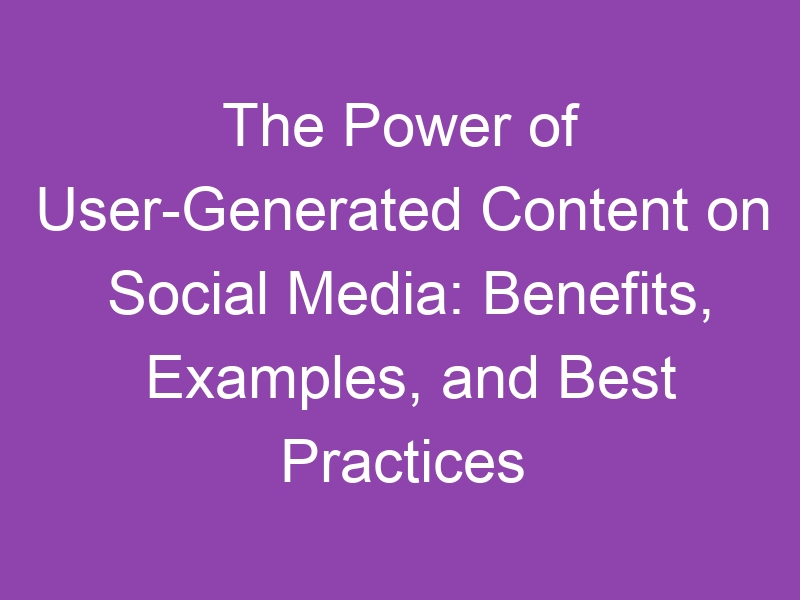Content Outline
- Introduction
- A. Definition of UGC Images
- B. Importance of UGC Images
- Benefits of using UGC Images
- How to find and curate UGC Images
- Best practices for using UGC Images on your website
- UGC Image copyright and legal considerations
- Conclusion
Introduction
In today’s digital age, user-generated content (UGC) has become an integral part of online marketing strategies. UGC images, in particular, have gained immense popularity due to their authenticity and ability to connect with audiences on a personal level. In this post, we will explore the benefits and drawbacks of using UGC images for your brand’s marketing.
- UGC images can help increase brand awareness and engagement on social media platforms such as Instagram and Facebook.
- According to a study by Olapic, UGC images can increase conversion rates by up to 4.6% compared to traditional brand-generated content.
- However, it is important to note that not all UGC images may align with your brand’s values and messaging, which can potentially harm your brand’s reputation.
- Additionally, obtaining legal permission to use UGC images can be a time-consuming process, and failure to do so can result in legal consequences.
Therefore, it is crucial to weigh the pros and cons of using UGC images and develop a well-planned strategy to ensure that your brand’s reputation is not compromised while also reaping the benefits of UGC images.
For more information on UGC images and their impact on marketing, check out this guide to UGC by Sprout Social.
Introduction – A. Definition of UGC Images
UGC images refer to user-generated content that is created and shared by users on various online platforms. These images are typically created by individuals who are not professional photographers or designers. Instead, they are created by regular people who capture moments in their daily lives and share them with others.
UGC images are becoming increasingly popular due to their authentic and relatable nature. They provide a glimpse into the real lives and experiences of people, which can be more engaging than staged or professional images.
However, there are also some challenges associated with UGC images. For example, they may not always be of high quality or may not align with a brand’s aesthetic. Additionally, there may be copyright or legal issues surrounding the use of UGC images.
Benefits of UGC Images
- Authenticity – UGC images are created by real people in real situations, making them more authentic and relatable than staged or professional images.
- Engagement – UGC images can be more engaging than other types of images because they provide a glimpse into the lives and experiences of real people.
- Cost-effective – Using UGC images can be a cost-effective way to create content because brands do not have to pay for professional photography or design.
Challenges of UGC Images
- Quality – UGC images may not always be of high quality, which can impact a brand’s aesthetic.
- Legal issues – There may be copyright or legal issues surrounding the use of UGC images, especially if they are used for commercial purposes.
- Brand alignment – UGC images may not always align with a brand’s aesthetic or values, which can impact their effectiveness.
In conclusion, UGC images can be a powerful tool for brands looking to create authentic and engaging content. However, it is important to be aware of the challenges associated with UGC images and to use them strategically to ensure they align with a brand’s goals and values.

Introduction – B. Importance of UGC Images
When it comes to online marketing, images have proven to be a powerful tool for engaging audiences and increasing conversions. However, not all images are created equal. User-generated content (UGC) images, which are images created and shared by users of a brand or product, have been found to be particularly effective in achieving marketing goals.
Why UGC Images Matter
- Authenticity: UGC images are often more authentic than branded images, as they are created by real people with genuine experiences of a product or service. This authenticity can help build trust with potential customers.
- Engagement: UGC images have been found to be more engaging than branded images, as they often showcase real people using and enjoying a product or service. This can help create an emotional connection with audiences and increase engagement metrics.
- Cost-effective: UGC images can also be a cost-effective way to generate content, as brands can leverage images created by their own followers rather than investing in expensive photo shoots.
According to a study by Olapic, UGC images can increase online conversions by up to 4.5%. Additionally, a survey by Stackla found that 86% of consumers consider authenticity to be an important factor when deciding which brands to support.
Conclusion
Overall, UGC images can be a valuable addition to any online marketing strategy. They offer a unique opportunity to showcase authentic experiences and engage audiences in a cost-effective way. However, it is important for brands to have a clear strategy and guidelines in place for using UGC images, as they come with their own set of challenges and legal considerations.
For more information on UGC images and how to leverage them in your marketing strategy, check out this article by Social Media Examiner.
Benefits of using UGC Images
- Increased authenticity: UGC images provide a genuine and realistic view of your brand, which can increase trust and credibility among your audience.
- Cost-effective: Using UGC images can save you money on expensive photoshoots or purchasing stock images.
- Increased engagement: UGC images have been shown to increase engagement rates on social media posts and website pages.
- Improved SEO: Incorporating UGC images into your website can improve your search engine rankings by providing fresh and relevant content for search engines to index.
- Diversify your content: UGC images can add diversity to your content, showcasing a wider range of perspectives and experiences.
According to a survey by Stackla, 79% of people say UGC highly impacts their purchasing decisions. Additionally, incorporating UGC images into your marketing strategy can lead to a 4.5% increase in conversion rates.
It’s important to note that using UGC images also comes with some tradeoffs. You may have less control over the quality and consistency of the images, and there may be legal considerations to keep in mind when using images created by others. However, overall, incorporating UGC images into your marketing strategy can provide numerous benefits for your brand.
Sources: Stackla Consumer Content Report 2021
How to Find and Curate UGC Images
UGC (user-generated content) images are a great way to add authenticity and diversity to your website or social media content. However, finding and curating these images can be a challenge. Here are some tips to help you:
- Utilize social media hashtags: Many users tag their photos with specific hashtags, making it easier for you to find relevant UGC images. For example, if you are looking for UGC images related to travel, search for hashtags like #travelgram or #wanderlust.
- Engage with your audience: Encourage your followers to share their photos with you by creating a branded hashtag and running a UGC campaign. This not only helps you find UGC images, but also increases engagement with your audience.
- Search for UGC platforms: There are many platforms that specialize in UGC, such as Tint and Pixlee. These platforms allow you to search for UGC images based on specific criteria, such as location or hashtag.
Once you have found UGC images, it is important to curate them properly:
- Get permission: Always ask for permission from the original owner before using their UGC image. This not only protects you legally, but also shows respect for the original creator.
- Credit the creator: When using UGC images, always credit the original creator. This can be done by adding a caption or tag to the image.
- Keep it relevant: Only use UGC images that are relevant to your brand and message. Using UGC images that are unrelated or low-quality can harm your brand image.
By following these tips, you can effectively find and curate UGC images for your website or social media content. Remember to always give credit where credit is due and stay authentic to your brand.
Best Practices for Using UGC Images on Your Website
UGC images, or user-generated content images, are a valuable asset for your website. They not only add authenticity to your brand but also give your customers a platform to showcase their experiences with your product or service. However, using UGC images on your website requires careful consideration and planning. Here are some best practices to follow:
- Always ask for permission: Before using any UGC image on your website, make sure to ask for permission from the user who posted it. This not only shows respect for their content but also protects you legally.
- Give credit where credit is due: Whenever you use a UGC image, make sure to give credit to the user who created it. This can be done by including their username or handle and linking to their profile or post.
- Curate carefully: Not all UGC images are suitable for your website. Make sure to curate the images carefully and only choose ones that align with your brand values and image.
- Consider the context: Before using a UGC image, consider the context in which it was originally posted. If the image was posted in a negative context, it may not be suitable for your website.
- Optimize for SEO: UGC images can also help with your website’s SEO. Make sure to include relevant keywords, such as “ugc images”, in the image file name, alt text, and caption.
Incorporating UGC images on your website can bring many benefits, but it’s important to follow these best practices to ensure a positive user experience and avoid any legal issues. According to a survey by Business 2 Community, 86% of millennials believe that UGC is a good indicator of the quality of a brand’s product or service. So, make sure to take advantage of this valuable resource while following these best practices!
UGC Image Copyright and Legal Considerations
When it comes to using User-Generated Content (UGC) images, there are several legal considerations that need to be taken into account. UGC images are any images that are created and shared by users on social media, blogs, or other online platforms. These images are often used by businesses for marketing and promotional purposes.
Understanding UGC Image Copyright Laws
One of the primary legal considerations when using UGC images is copyright law. Copyright law protects the original creator of an image and gives them exclusive rights to use and distribute that image. In order to use UGC images legally, businesses must obtain permission from the original creator.
There are several ways to obtain permission, including:
- Asking the creator directly for permission
- Using images that are licensed under Creative Commons
- Using a third-party platform that provides licensed UGC images
It is important to note that simply giving credit to the original creator is not enough to avoid copyright infringement. Permission must be obtained before using the image.
Other Legal Considerations
In addition to copyright laws, there are other legal considerations that need to be taken into account when using UGC images. These include:
- Privacy rights of individuals in the image
- Trademark laws if any logos or branding are included in the image
- Defamation laws if the image includes any false or misleading information
The Benefits of Using UGC Images
Despite the legal considerations, using UGC images can provide several benefits for businesses, including:
- Increased engagement and interaction with customers
- Cost-effective marketing and advertising
- Authenticity and relatability for the audience
According to a survey by Adweek, UGC images generate a 4.5% higher conversion rate than non-UGC images.
Conclusion
Using UGC images can be a great way for businesses to connect with their audience and promote their brand. However, it is important to understand the legal considerations and obtain proper permission before using any UGC images. By doing so, businesses can avoid legal issues and reap the benefits of using this powerful marketing tool.
Conclusion
In conclusion, incorporating user-generated content (UGC) images into your website can have both positive and negative impacts on your overall SEO strategy. While UGC images can add valuable and authentic content to your website, they also come with the risk of low-quality and irrelevant images that can harm your SEO efforts.
It’s important to carefully curate and moderate UGC images to ensure that they align with your brand and add value to your website. Additionally, implementing alt tags and captions for UGC images can help improve their relevance and accessibility for search engines.
Overall, when used strategically and thoughtfully, UGC images can enhance your website’s SEO and user engagement. It’s important to weigh the potential benefits and drawbacks before incorporating UGC images into your website.
Sources:



